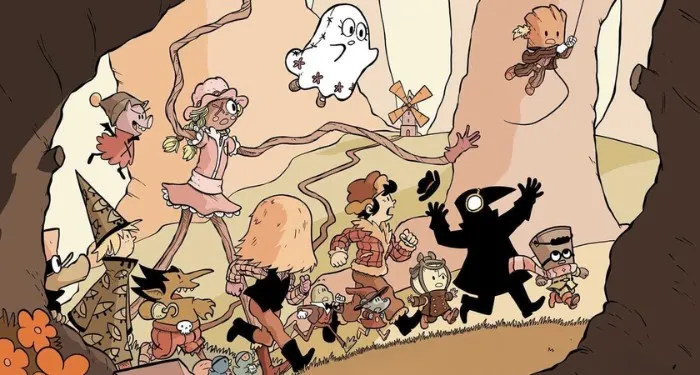In 1792 Thomas Erskine—“the most enlightened liberal of his times,” as one biographer called him—stood before a London jury to defend the latest installment of Thomas Paine’s Rights of Man against charges of seditious libel. The Crown, spooked by the upheaval in France and nervous about copycat radicals at home, had decided that Paine’s attacks on monarchy and privilege were too dangerous to circulate.
The prosecutor, Sir Archibald Macdonald, was especially worried about cheap editions of the book reaching those who “cannot be supposed to be conversant with subjects of this sort, and who cannot therefore correct as they go along.” Erskine, with his implacable eloquence, insisted that a citizen must be free to “address himself to the universal reason of a whole nation”—that progress depended on it. “The cause,” he declared, “resolves itself into a question of the deepest importance to us all, the nature and extent of the liberty of the English press.” He lost.
Five years later Paine’s Age of Reason landed in court before the same judge. Erskine was back, too, only this time he was the prosecutor, guardian of the public, and this time he prevailed. The poor and humble, he warned, would be “stabbed to the heart” by the book’s assault on religion, for they “have more occasion for firm hopes beyond the grave, than those who have greater comforts to render life delightful.” Press freedom, he now argued, was not a license to undermine the very foundations of government and faith. Even the most enlightened liberal of the time, it turned out, preferred his liberalism in moderation.
Erskine is just one in a long line of idealists, opportunists, and equivocators who zigzag through What Is Free Speech?, Fara Dabhoiwala’s fascinating and intellectually agile new history. As Dabhoiwala shows, the concept of free speech was always a bundle of contending impulses responsive to shifting local priorities. Its boundaries—who could speak, about what, and to whom—remained uncertain and unsettled. Poring over pamphlets and petitions, Dabhoiwala writes about these early battles with clarity and bite. Revered free speech forebears, under his merciless scrutiny, often turn out to contradict themselves freely, their motives as sordid as their slogans were noble.
At the core of the book are these noisy, unfinished, improvisatory arguments that shaped and reshaped what “free speech” meant in the eighteenth and nineteenth centuries. Dabhoiwala has little patience for the tidy story of liberal progress. There was never a single, expanding right, just a jumble of contested claims and carve-outs.
In the early decades of the eighteenth century, when arguments for free speech began to crystallize, the usual lodestars were John Milton’s Areopagitica (1644) and John Locke’s Letter Concerning Toleration (1689). Both contended that truth would triumph when error had to meet it in the open, that coerced belief was futile, that conscience must be won over by argument. But both cases for liberty were tightly circumscribed: Milton’s defense of unlicensed printing stopped at “popery, and open superstition,” while Locke’s toleration excluded not only Catholics and atheists but the intolerant themselves. Pleas for liberty, as Dabhoiwala shows, were tailored to the temper of their times.
The book’s standout chapter digs into Cato’s Letters, a series of anonymous essays that Thomas Gordon and John Trenchard churned out in the London Journal in the early 1720s. Dabhoiwala makes the case that they shaped British and American ideas about liberty of speech and the press more than any other work of the century. Endlessly reprinted, passed from hand to hand, the Letters staked out a new, secular ideal: free speech as the “very foundation of all liberty.” When the government struck back—arresting the London Journal’s staff and smashing the press—the raids only burnished Cato’s reputation as a fearless truth teller. Nothing builds a brand, it seems, like a little persecution.
Dabhoiwala grounds these polemics in their own raucous moment—a volatile press, fresh political fissures, the aftershocks of the Glorious Revolution of 1688. But he’s unsparing about how flimsy their claims could be. Would truth really flatten falsehood in open combat? Gordon and Trenchard seemed to think so, claiming that any “misrepresentation of public measures is easily overthrown” by simply “representing public measures truly” and that the people “generally make a sound judgment of things.” Nor does Dabhoiwala give them any credit for originality: in his view, their defense of political speech was just a remix of older arguments about religious liberty of expression.
Gordon and Trenchard occasionally invoked “the Right of every Man,” but Dabhoiwala shrewdly points out that they mostly defended collective rights—“the people’s” freedom to speak. Liberty, they held, meant being free to write and talk as long as you didn’t harm others. But harm, by their logic, would be determined by the very public they mythologized as largely immune to it. Meanwhile Cato’s Letters had almost nothing to say about the messier realities of the press—the race for readers, the torrent of political lying, the fact that, as Dabhoiwala writes, “spreading misinformation and propaganda for profit was intrinsic, not incidental, to the world’s first ‘free’ press.”
Trenchard died in 1723, but not before securing his young coauthor a post with Robert Walpole’s ministry. Gordon soon put his pen to work defending the establishment, idealizing the wisdom of the rulers (“Guardian Angels of the Land”) rather than the ruled. The fearless truth teller grew rich—as Walpole’s secret censor. In Dabhoiwala’s tart summation, “The first modern theory of political free speech was a self-serving tissue of deliberate fabrications, glaring contradictions, and wilful omissions.”
This mattered, because its influence ran deep, especially in North America. Colonial newspapers canonized Cato’s slogans; soon rebellious states parroted them in their declarations of rights. When the First Amendment was drafted in 1789, it took up the Trenchard–Gordon template, declaring that “Congress shall make no law…abridging the freedom of speech, or of the press” and creating what Dabhoiwala calls “the most powerful free-speech law in the world” on the most slipshod of foundations.
Here, he suggests, is the con at the heart of the Constitution. Other nations, he writes, adopted a notion of expressive liberty qualified by the balancing of public interests; other nations could prevent free speech protections from sweeping aside social justice concerns and readily ban language that foments hatred and hurts the vulnerable. Americans were left with their beautiful, terrible inheritance.
Dabhoiwala’s historical excavations are often dazzling, and those taken by absolutist slogans will find their certainties smartly rattled. He’s less persuasive when he pins America’s political ills on that fateful amendment or assumes the superiority of more aggressive regulatory regimes. When it comes to the tarnished origins of a seemingly gleaming ideal, the book’s readers should be prepared to learn much that is disquieting; when it comes to the politics of the modern era, they should also, in Sir Archibald Macdonald’s wistful words, be prepared to “correct as they go along.” In the end we may not wish to trade away our inheritance. But we owe it to ourselves to understand how we came by it, and at what cost.
Given Dabhoiwala’s iconoclasm, it’s no surprise that John Stuart Mill—the most enlightened liberal of his time—fares no better than his predecessors. Still, as the book’s treatment of him shows, the bracing habit of seeing through arguments can sometimes impede the work of looking at them.
What’s true is that the author of On Liberty spent decades as a functionary of the East India Company, and though he deplored racism and celebrated intellectual diversity, he saw non-European cultures as backward—not yet ready for the liberty he championed. (The individual, Mill argued, was sovereign over himself, but “it is, perhaps, hardly necessary to say” that this doctrine did not apply to “backward states of society in which the race itself may be considered as in its nonage.”) In Dabhoiwala’s view, this isn’t just a personal failing; he thinks that Mill’s doubts about free speech in “backward” societies help explain his reluctance to face its messier consequences at home.
Interrogating Mill’s complicity with imperialism, Dabhoiwala aligns himself with a prominent line of argument that since the 1990s has routinely invoked Mill to argue that liberalism is conceptually entangled with empire. In the usual academic procession, what begins as revisionism hardens into orthodoxy, and this one has spawned a counterliterature that, as the scholar Georgios Varouxakis notes, sometimes goes too far in the opposite direction. But the pressing question is whether Mill’s apologetics for empire really shaped his apologetics for liberty.
One problem with the case for colonial contamination is that the conceptual spine of On Liberty, as Mill made plain, came from early work by Wilhelm von Humboldt, who was from Prussia, a country with no colonies to manage, and writing half a century before Mill. (Many years later, as Prussia’s director of ecclesiastical affairs, he was forced to take charge of literary censorship.) Dabhoiwala, approaching Mill like a prosecutor preparing a brief, can sometimes mistake complexity for contradiction. He’s quick to pounce on Mill’s statement that the freedom to express opinions—although it “belongs to that part of the conduct of an individual which concerns other people”—is, in practice, inseparable from liberty of thought. Dabhoiwala decries this as an “extraordinary assertion,” patent sophistry that “Mill tries to smuggle past his readers as furtively as possible.”
But for Mill the idea was central. Drawing on Humboldt’s ideas about Bildung—self-development—Mill saw the freedom to speak and publish in relation to its complement: the freedom to hear and read. Freedom of thought, for Mill, demanded exposure to a range of views, even those the state found inconvenient. Curtail expression, and you inevitably curtail cogitation. Thinking wasn’t something private and hermetically sealed; our beliefs and opinions took shape in the very act of expressing them—through conversation, writing, debate. “Language,” he wrote elsewhere, echoing a point made by philosophers at least as far back as Hobbes, “is an instrument of thought, as well as a means of communicating our thoughts.”
Mill was clear that liberty had its limits: a person “must not make himself a nuisance to other people.” Dabhoiwala isn’t impressed: he charges that Mill never “stooped to consider how such restrictions were to be reconciled with ‘absolute freedom of opinion and sentiment on all subjects.’” But Mill’s talk of “absolute freedom” explicitly referred to the inward domain of thought, not to public expression. These liberties were, in his view, connected but not coterminous.
The greatest sin of On Liberty, in Dabhoiwala’s account, is to theorize free speech, a social activity, “wholly as an individual right.” In fact, Mill was notably chary about “rights,” declaring at one point, “I forego any advantage which could be derived to my argument from the idea of abstract right, as a thing independent of utility.” Rights for him were merely rules of thumb justified by their consequences. He didn’t accept the absolutism of rights, whether claimed by individuals or claimed by governments.
The Humboldtian core of On Liberty is simple but powerful: the burden of justification falls not on the people who want to speak their minds but on the authorities who want to silence them. This conception may render free speech, as Dabhoiwala suspects, an essentially negative liberty, a “freedom from” rather than a “freedom to.” But then a great many cherished values are negative in form: due process, equal protection, privacy—all are legal artifacts defined by the abuses that violate them. We’ll fail to get agreement about what’s meant by “fairness,” but even children have a keen sense for its absence. (“No fair!” the toddler protests.) The very concept of freedom, as Orlando Patterson has argued at length, arose in contrast to the condition of slavery. In being defined through negation—as a constraint on constraint—free speech need not hang its head; it’s keeping excellent company.
The First Amendment, old on paper, is modern in practice. Only in the past hundred years did it acquire the force and sweep we now associate with it. During and after World War I, socialists saw the amendment as a possible shield, while Justices Oliver Wendell Holmes Jr. and Louis Brandeis, initially in dissent, started to outline a theory of free speech as crucial to democratic deliberation. From the outset there was a clash of visions. The agitators of the time, Dabhoiwala writes, viewed free speech not as an individual entitlement, as Holmes and Brandeis tended to, but as a tool for collective action—the right to strike, picket, and organize.
Yet when the modern doctrine of free speech truly came into its own, during the Warren Court’s heyday, collective action stood at its center. Decisions upholding protests, boycotts, and sit-ins aimed at Jim Crow tied the right to speak to the right to demand justice. (These decisions, in turn, drew on precedents in which loathsome speakers secured broadened rights to political speech.) Noble origins no more ensure a doctrine’s virtue than ignoble ones its vice. Still, if you share Dabhoiwala’s worries that the First Amendment preempts social justice concerns, it’s worth noting how closely they were, in fact, entwined.
As What Is Free Speech? draws closer to the present, Dabhoiwala becomes less historian, more advocate. “This is not a book about legal history,” he stresses in his introduction, “but about the politics of free speech more generally.” The two are, of course, intimately connected. Just as the Second Amendment has been invoked to thwart meaningful gun regulation—leaving the US peculiarly awash in firearms and violence—the First Amendment, in Dabhoiwala’s view, has produced a uniquely polluted public sphere. Especially since a “libertarian revolution in First Amendment jurisprudence over the past few decades,” it has become harder to limit speech and harder to protect vulnerable communities from it.
For him, any responsible politics must grapple with the question he takes to be fundamental: “What is freedom of expression for?” In the United Kingdom, unburdened by First Amendment absolutism, that question can guide policies and prosecutions. Dabhoiwala writes about the Crown’s prosecution of the antisemitic editor of The Fascist for seditious libel in the 1930s and the passage of the 1965 Race Relations Act, which banned speech inciting racial hatred.
But by the book’s later chapters, a curious asymmetry emerges: speech protections are assessed by their most troubling consequences, while speech restrictions are assessed by their loftiest aims. So it’s worth noting the complications missing from Dabhoiwala’s account, such as the fact that the ban on seditious libel that ensnared the editor of The Fascist was more broadly wielded against left-wing activists. As for the Race Relations Act’s prohibition on the incitement of racial or ethnic hatred, most of those convicted of the offense within five years of its adoption were people of color—beginning with Michael X, who was one of several Black nationalists convicted in 1967 of stirring up animosity against white people. Are such measures the best way to protect minorities? Color me unconvinced.
Though Dabhoiwala briskly concedes that group protections may go astray in practice, what moves him are the values they enshrine in theory. Deriding or degrading people on account of race or national origins, he writes with simple gravity, “is not what the right of free speech is for.” Well, no. But neither is free speech “for” making terrible puns, interrupting with inane remarks, misquoting Audre Lorde, warning a character on a movie screen not to open the basement door (please, she can’t hear you), repeating the same story for the twentieth time, or blurting out the punchline when your friend tells a joke. We might return to the thought that in a liberal order, the burden of justification ought to fall on those who would silence, not those who would speak. Rather than trying to say what an instance of speech is for, we’ll do better to ask what an act of suppression is for.
What Is Free Speech? presents the First Amendment as the republic’s resident poltergeist—knocking pictures off the wall, leaving radios blaring, unsettling every attempt at order. But the only ghosts here are those we choose to conjure. For one thing, the amendment has never meant what it says—not when it pertained only to congressional acts, not when it came to apply more broadly. As the late legal scholar Frederick Schauer, the nimblest of First Amendment deflationists, observed more than once, plenty of what might seem to count as “speech”—such as securities fraud, antitrust violations, criminal solicitation, hostile-environment harassment, and trademark infringement—lies beyond its purview. American free speech doctrine has always been a dense latticework of exceptions. The amendment’s words have no magic. Even the Roberts Court’s much-vaunted textualism makes itself scarce when First Amendment cases come calling.
In Dabhoiwala’s accounting, the First Amendment was accursed from the start, but America’s approach to free speech became so only in recent decades. He must therefore explain a variable with a constant. If it took a “libertarian revolution” to expose the amendment’s textual toxicity, you’d think the real question is what forces propelled that revolution. And because he thinks this toxicity consists in precluding a crucial balancing of liberty rights against public interests, we have to contend with the awkward fact that American free speech law has always been in the balancing business.
It’s true that courts have backed away from talking about ad hoc balancing, in part because critics across the spectrum have exposed its shortcomings. It asks judges to trade off incommensurable values—say, free expression and national security—and to sort through empirical claims about harm that they may be ill-equipped to resolve. Government security interests can seem concrete and urgent, while speech rights seem abstract and diffuse, leading to the tilt toward suppression that marked Justice Felix Frankfurter’s balancing strategy in the 1950s.
So the Supreme Court now sorts speech into tiered categories. Political speech typically receives the highest protection—strict scrutiny, requiring that any rule or enforcement action serve a “compelling” government interest and be “narrowly tailored” to it. Commercial speech gets less. Other types of speech (obscenity, speech integral to crime) may get no protection at all. With respect to state actions, strict scrutiny falls on content-based restrictions, lesser scrutiny on content-neutral ones. For all that, balancing never went anywhere. What makes an interest “compelling” except a judge’s sense of its relative weight? How does one decide if a measure is “narrowly tailored” without weighing benefits against burdens?
And when we hold the First Amendment to blame for bad Supreme Court decisions (the book gives it no credit for good ones), aren’t we adopting a kind of textualist determinism, imagining that the amendment itself simply dictates judicial outcomes? Consider Citizens United v. Federal Election Commission, in which the majority held that limits on political spending by corporations and unions violated their expressive liberties. According to the four dissenting justices, this result was actually at war with the amendment, properly construed. Were they wrong?
With a hint of reproach, Dabhoiwala observes that the First Amendment was crafted by rebels profoundly distrustful of government power. But Schauer, who delightedly tore into theories about what free speech was “for,” made a persuasive case that distrust was the best argument for strong speech protections—starting with distrust that the government will “make the necessary distinctions.” This wasn’t grand theory; it was the historically informed conclusion that authority, given the chance, will find reasons to silence what threatens it. Entrenching a contrary norm is, at the very least, a way to make that impulse harder to indulge. If Cato’s Letters idealized the people, idealizing their rulers, those Guardians of the Land, was always a poor course correction.
Dabhoiwala finds it troubling that American free speech jurisprudence “has gradually abandoned any conception of the common good.” Adrian Vermeule, a conservative Harvard Law professor known for his neo-Thomist “common-good jurisprudence,” finds this troubling, too—and there’s the rub. Who gets to define the common good? At its most tendentious, What Is Free Speech? minimizes the distinction between supporting the rights of speakers and supporting what they say. Dabhoiwala charges that the ACLU, in actively defending the speech rights of bigots, “was inevitably also always normalizing and amplifying their message” and that “its actions proclaim that even the most hateful, untrue or otherwise toxic views are worthy of public dissemination—that these are ideas that deserve to be heard.” By this logic, the defense of due process would normalize or legitimate a criminal’s offenses. And hadn’t Dabhoiwala shown us that official attempts to suppress speech—as with Cato’s Letters—could amplify what they meant to mute?
The reissue of Aryeh Neier’s Defending My Enemy: Skokie and the Legacy of Free Speech in America is a timely reminder that the ACLU’s old-guard approach to free speech was anything but naive. Neier, a refugee from Nazi Germany, was the ACLU’s national director in 1977 when it defended a neo-Nazi party’s right to march in Skokie, Illinois. He simply didn’t think government could always be trusted to pick “enemies of freedom.” Was he mistaken? A great many American Muslims were prosecuted under the federal “material support” statute after September 11, but Jameel Jaffer, who litigated such cases for the ACLU, has made the point that many more would have been imprisoned were it not for a Supreme Court precedent upholding the rights of a white supremacist.
In the aftermath of the Skokie case, the Nazis gained no support, while Skokie gained a museum for Holocaust remembrance. What the high-profile case really “amplified” was the notion that tolerating speech was no judgment on its worth. What it “normalized” was a crevasse between permission and approval—making it plain that a permit was no badge of legitimacy.
Max Weber famously distinguished between the ethics of conviction, which call on you to uphold your principles, and the ethics of responsibility, which require you to answer for the consequences of your actions. Dabhoiwala tends to judge civility codes by the first yardstick, the First Amendment by the second. Because he blames the First Amendment for America’s degraded public discourse, it’s unsurprising that Britain, with its more expansive regulations, comes out better in his book. The UK has the Racial and Religious Hatred Act, the Communications Act of 2003, and a raft of Public Order Acts all framed in ways that wouldn’t fly in the US and all embodying commendable ideals. But the ethics of responsibility can’t be brushed aside with a quick “to be sure.” American public discourse is often appalling—who could deny it? But Britain’s tangle of speech restrictions is hardly an appealing alternative.
If we want to avoid the problem of asymmetrical idealization, we should pay attention when human rights groups complain that such laws fall heaviest on people of color and radicals. We should pay attention when they worry that the line between dissent and incitement is routinely blurred—as when British authorities arrested a Muslim teenager in West Yorkshire for an offensive social media post about British soldiers. Earlier this year a Hertfordshire couple with a disabled daughter was jailed after criticizing school administrators in a private WhatsApp group. Around the same time, a grandmother near Manchester called for the resignation of her town councillor, who, it emerged, had been part of a WhatsApp chat where snarky remarks about Jews, Blacks, and others were made; police came to her door to warn her that a complaint had been filed against her. The Communications Act (which prohibits “grossly offensive” material whether or not offense was intended or taken), along with a similar, older statute, leads to something on the order of 12,000 arrests in Britain each year. When Reverend Sue Parfitt, eighty-three, was arrested this summer in Parliament Square for holding a placard expressing support for Palestine Action (a recent ban had made such support punishable by up to fourteen years in prison), she did not seem glad to have been spared First Amendment protections. She likely spoke for the two hundred or so people arrested for the same offense when she lamented the “loss of civil liberties in this country.”
As for the mainstream media, the UK has become a magnet for libel tourism, with wealthy elites taking advantage of the country’s plaintiff-friendly courts to stifle critical reporting. In British defamation cases, journalists, not plaintiffs, bear the burden of proving the truth of their claims. Preemptive self-censorship is routine. The Official Secrets Act, criminalizing the publication of classified material even when the journalist obtained it lawfully, has a history of being used to quash embarrassing revelations. Judges routinely issue nationwide bans on reporting or commenting on ongoing trials. A commodities trading firm that got the media barred from mentioning a leaked internal report on its involvement in toxic waste dumping—and barred from mentioning the injunction itself—even managed at first to prevent The Guardian from reporting that a Labour MP had raised the matter in Parliament.
Despite all this policing, curiously, tabloids in the UK—and they remain central to the national discourse—can be shamelessly reckless. Long before Trump megaphoned a social media tale of pet-eating immigrants, The Sun whipped up outrage with headlines about immigrants barbecuing royal swans, a whole-cloth invention complete with fabricated police quotes. (A rival tabloid ran with a tale of Somali asylum seekers gobbling up donkeys from a London royal park, evidently unaware that domesticated donkeys are haram.) British journalism can be both fragile and feral.
Worrying about the so-called mainstream media can seem nostalgic when that mainstream is increasingly in the hands of social media. In Dabhoiwala’s view, platforms like Facebook are simply exporting the original sin of First Amendment absolutism worldwide. But take a closer look. If anything, Facebook’s evolution underscores how far it has drifted from America’s free speech doctrines. After the Rohingya massacres in Myanmar in 2017, the company scrambled to hire Burmese-speaking moderators and ban various nationalist figures—often fumbling the results but unmistakably tightening control. Facebook’s community standards prohibit hate speech, harassment, praise for criminals or terrorists, even stray jabs at national character. Posting “Irish are the best, but really French sucks,” an example from its internal instructional material, would be a violation. During the pandemic and the 2020 election, it removed millions of posts deemed to be misinformation (including posts suggesting that Covid-19 may have originated from a lab leak), coordinated with health authorities, and, after January 6, suspended Trump, breaking its own “newsworthiness” precedent. Its policies, like the Vicar of Bray’s, are pragmatic and in constant flux—shaped not by ideology but by regulatory threats, political calculations, shifting social norms. It comfortably invokes international human rights standards and seldom mentions American constitutional values. If Facebook is exporting anything, it’s an uneasy civility code—one that favors order and safety over liberty and too often falls short on all counts.
Dabhoiwala is at his best when he troubles our assumptions and invites us to revisit the familiar stories we tell about free speech. But his arraignment of the First Amendment can feel like the exchange of one set of dogmas for another—newer, perhaps, and more in step with current academic thinking, but just as totalizing as the ones he seeks to dislodge. Where he’s most worth following is in directing our attention to the stubborn tensions that persist in our efforts to govern speech—a reminder that they’re not so much problems to be solved as conditions for unending negotiation.
Reading this book, with its unflinching interrogation of free speech ideologues, I found myself reflecting that an equally damning history could be written about democracy, a term that before the eighteenth century was typically one of reproach. Early English defenders, from James Harrington to Richard Price, made rather slippery arguments for it, while various French revolutionaries veered between zealotry and hypocrisy—the comte de Mirabeau, that golden-tongued tribune of the people, was secretly on the royal payroll; Joseph Fouché, incarnadine in his fervor for democracy, went on to suppress it as Napoleon’s police chief before serving the restored Bourbons. Foundational principles shouldn’t conceal their ancestral sins, but neither should they be judged by them.
Dabhoiwala’s book arrives at an awkward juncture for our own fragile and fallible democracy. He began work on it a decade ago, when campuses saw the most enlightened liberals of their time enlisting an expansive notion of harm and safety to critique free speech shibboleths, squaring off against conservatives enamored of them. (Many earlier conservative thinkers, notably Robert Bork, were aghast at the Warren Court’s permissiveness toward expressive liberties.) “Free Speech is American,” Representative Elise Stefanik tweeted in 2022. “Censorship is Communism.”
As in the free speech contests of Thomas Erskine’s day, however, positions could be reversed with disorienting speed. Especially since the last presidential election, conservatives, backed by state power, have demanded punishment for student protesters whose views they deplore and further punishment for universities that declined to eject them; progressives, in turn, have rediscovered the value of robust protections for contested speech. The Trump administration, meanwhile, has run roughshod over free speech considerations. In response, a string of consequential court rulings in recent months—freeing students detained for their opinions, suspending the mass cancellation of student visas, blocking punitive actions against law firms, halting the mass firing of Voice of America journalists, enjoining the cancellation of federal research grants—have invoked the First Amendment in reversing executive decisions. This is far from a story of triumph. Still, the amendment, for all its frailties, has proved a singularly valuable resource in trying to resist assaults on democratic norms. Dabhoiwala’s readers might think twice before joining the movement to trample it underfoot.
When Dabhoiwala takes us through the period when our concepts of expressive liberty were forged, we’re seldom gladdened when a printer or pamphleteer is prosecuted. The record he presents belies the fantasy that a more tightly regulated public square is bound to be a more just one. The First Amendment has to be assessed not only by the harms it permits but by those it prevents. Such freedom, the skeptics insist, is not an unalloyed good. They’re right—it’s an alloyed good. But alloyed goods, as the history of our free speech battles confirms, are the only kind we ever get.



















 English (US) ·
English (US) ·